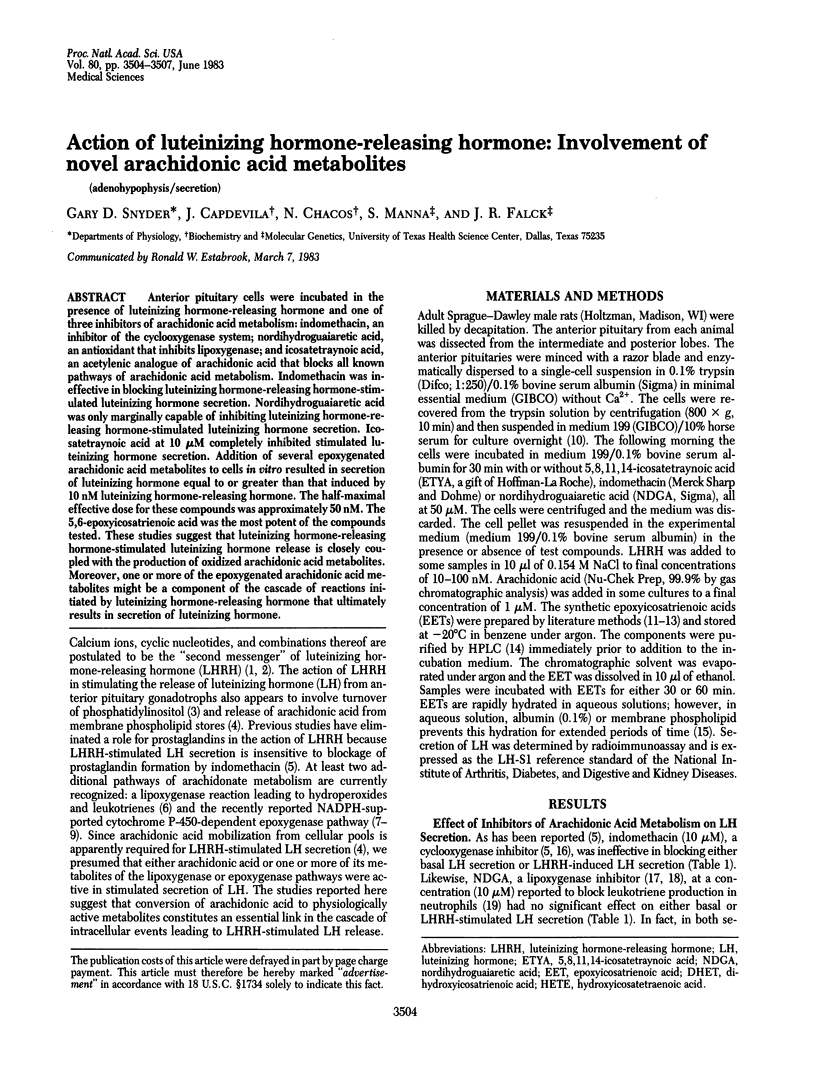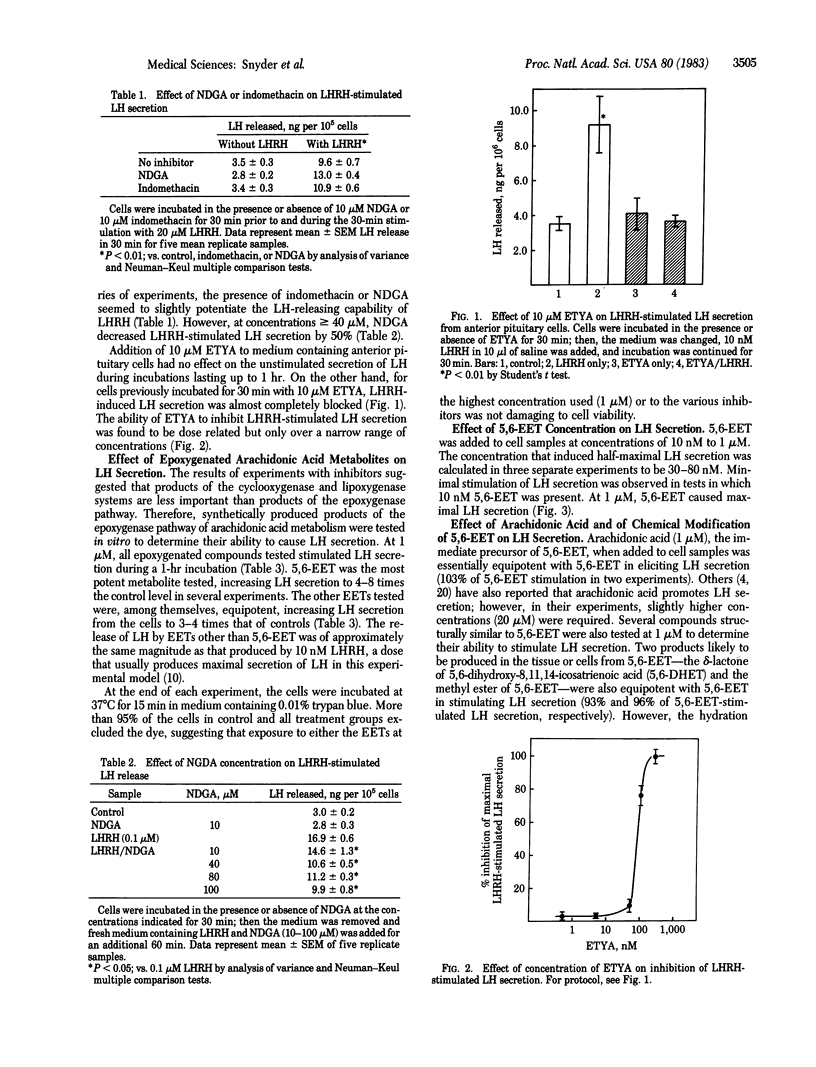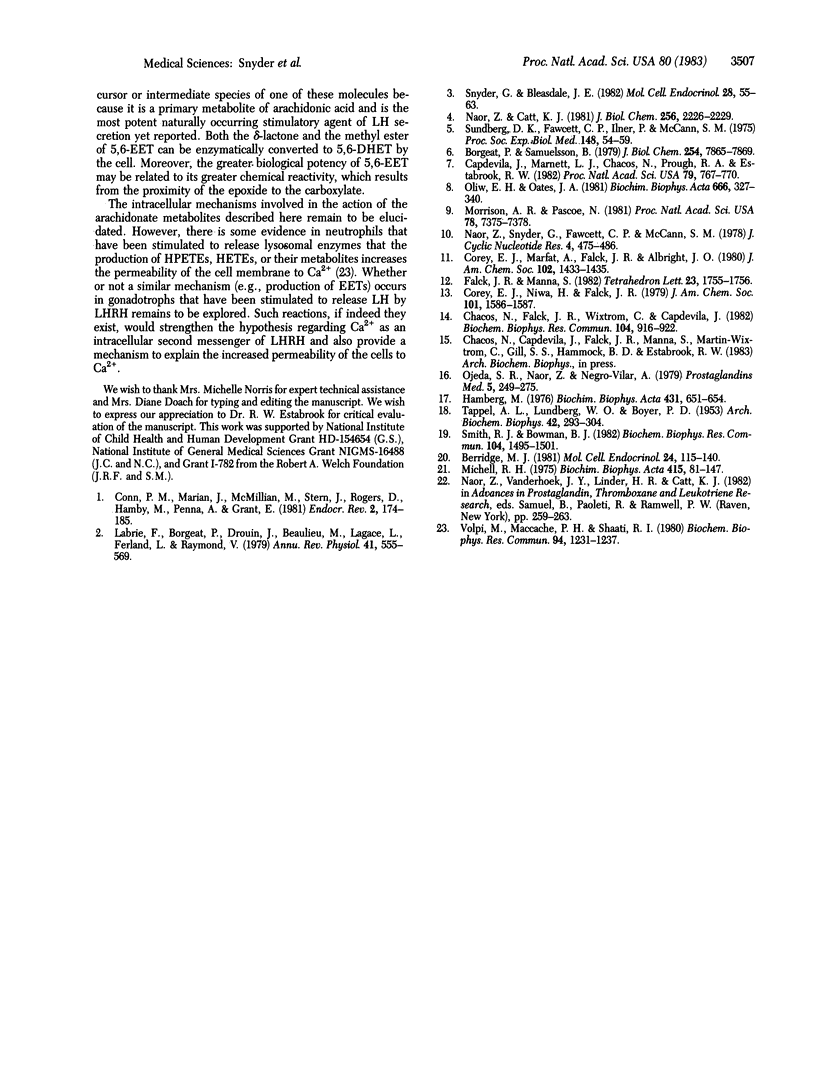Abstract
Anterior pituitary cells were incubated in the presence of luteinizing hormone-releasing hormone and one of three inhibitors of arachidonic acid metabolism:indomethacin, an inhibitor of the cyclooxygenase system; nordihydroguaiaretic acid, an antioxidant that inhibits lipoxygenase; and icosatetraynoic acid, an acetylenic analogue of arachidonic acid that blocks all known pathways of arachidonic acid metabolism. Indomethacin was ineffective in blocking luteinizing hormone-releasing hormone-stimulated luteinizing hormone secretion. Nordihydroguaiaretic acid was only marginally capable of inhibiting luteinizing hormone-releasing hormone-stimulated luteinizing hormone secretion. Icosatetraynoic acid at 10 microM completely inhibited stimulated luteinizing hormone secretion. Addition of several epoxygenated arachidonic acid metabolites to cells in vitro resulted in secretion of luteinizing hormone equal to or greater than that induced by 10 nM luteinizing hormone-releasing hormone. The half-maximal effective dose for these compounds was approximately 50 nM. The 5,6-epoxyicosatrienoic acid was the most potent of the compounds tested. These studies suggest that luteinizing hormone-releasing hormone-stimulated luteinizing hormone release is closely coupled with the production of oxidized arachidonic acid metabolites. Moreover, one or more of the epoxygenated arachidonic acid metabolites might be a component of the cascade of reactions initiated by luteinizing hormone-releasing hormone that ultimately results in secretion of luteinizing hormone.
Full text
PDF



Selected References
These references are in PubMed. This may not be the complete list of references from this article.
- Berridge M. J. Phosphatidylinositol hydrolysis: a multifunctional transducing mechanism. Mol Cell Endocrinol. 1981 Nov;24(2):115–140. doi: 10.1016/0303-7207(81)90055-1. [DOI] [PubMed] [Google Scholar]
- Borgeat P., Samuelsson B. Metabolism of arachidonic acid in polymorphonuclear leukocytes. Structural analysis of novel hydroxylated compounds. J Biol Chem. 1979 Aug 25;254(16):7865–7869. [PubMed] [Google Scholar]
- Capdevila J., Marnett L. J., Chacos N., Prough R. A., Estabrook R. W. Cytochrome P-450-dependent oxygenation of arachidonic acid to hydroxyicosatetraenoic acids. Proc Natl Acad Sci U S A. 1982 Feb;79(3):767–770. doi: 10.1073/pnas.79.3.767. [DOI] [PMC free article] [PubMed] [Google Scholar]
- Chacos N., Falck J. R., Wixtrom C., Capdevila J. Novel epoxides formed during the liver cytochrome P-450 oxidation of arachidonic acid. Biochem Biophys Res Commun. 1982 Feb 11;104(3):916–922. doi: 10.1016/0006-291x(82)91336-5. [DOI] [PubMed] [Google Scholar]
- Conn P. M., Marian J., McMillian M., Stern J., Rogers D., Hamby M., Penna A., Grant E. Gonadotropin-releasing hormone action in the pituitary: a three step mechanism. Endocr Rev. 1981 Spring;2(2):174–185. doi: 10.1210/edrv-2-2-174. [DOI] [PubMed] [Google Scholar]
- Hamberg M. On the formation of thromboxane B2 and 12l-hydroxy-5,8,10,14-eicosatetraenoic acid (12 ho-20:4) in tissues from the guinea pig. Biochim Biophys Acta. 1976 Jun 22;431(3):651–654. doi: 10.1016/0005-2760(76)90232-0. [DOI] [PubMed] [Google Scholar]
- Labrie F., Borgeat P., Drouin J., Beaulieu M., Lagacé L., Ferland L., Raymond V. Mechanism of action of hypothalamic hormones in the adenohypophysis. Annu Rev Physiol. 1979;41:555–569. doi: 10.1146/annurev.ph.41.030179.003011. [DOI] [PubMed] [Google Scholar]
- Michell R. H. Inositol phospholipids and cell surface receptor function. Biochim Biophys Acta. 1975 Mar 25;415(1):81–47. doi: 10.1016/0304-4157(75)90017-9. [DOI] [PubMed] [Google Scholar]
- Morrison A. R., Pascoe N. Metabolism of arachidonate through NADPH-dependent oxygenase of renal cortex. Proc Natl Acad Sci U S A. 1981 Dec;78(12):7375–7378. doi: 10.1073/pnas.78.12.7375. [DOI] [PMC free article] [PubMed] [Google Scholar]
- Naor Z., Catt K. J. Mechanism of action of gonadotropin-releasing hormone. Involvement of phospholipid turnover in luteinizing hormone release. J Biol Chem. 1981 Mar 10;256(5):2226–2229. [PubMed] [Google Scholar]
- Naor Z., Snyder G., Fawcett C. P., McCann S. M. A possible role for cyclic GMP in mediating the effect of luteinizing hormone releasing hormone on gonadotropin release in dispersed pituitary cells of the female rat. J Cyclic Nucleotide Res. 1978 Dec;4(6):475–486. [PubMed] [Google Scholar]
- Ojeda S. R., Naor Z., Negro-Vilar A. The role of prostaglandins in the control of gonadotropin and prolactin secretion. Prostaglandins Med. 1979 Apr;2(4):249–275. doi: 10.1016/0161-4630(79)90060-0. [DOI] [PubMed] [Google Scholar]
- Oliw E. H., Oates J. A. Oxygenation of arachidonic acid by hepatic microsomes of the rabbit. Mechanism of biosynthesis of two vicinal dihydroxyeicosatrienoic acids. Biochim Biophys Acta. 1981 Dec 23;666(3):327–340. doi: 10.1016/0005-2760(81)90291-5. [DOI] [PubMed] [Google Scholar]
- Smith R. J., Bowman B. J. Stimulation of human neutrophil degranulation with 1-O-octadecyl-2-O-acetyl-SN-glyceryl-3-phosphorylcholine: modulation by inhibitors of arachidonic acid metabolism. Biochem Biophys Res Commun. 1982 Feb 26;104(4):1495–1501. doi: 10.1016/0006-291x(82)91420-6. [DOI] [PubMed] [Google Scholar]
- Sundberg D. K., Fawcett C. P., Illner P., McCann S. M. The effect of various prostaglandins and a prostaglandin synthetase inhibitor on rat anterior pituitary cyclic AMP levels and hormone release in vitro (38475). Proc Soc Exp Biol Med. 1975 Jan;148(1):54–59. doi: 10.3181/00379727-148-38475. [DOI] [PubMed] [Google Scholar]
- TAPPEL A. L., LUNDBERG W. O., BOYER P. D. Effect of temperature and antioxidants upon the lipoxidase-catalyzed oxidation of sodium linoleate. Arch Biochem Biophys. 1953 Feb;42(2):293–304. doi: 10.1016/0003-9861(53)90359-2. [DOI] [PubMed] [Google Scholar]
- Volpi M., Naccache P. H., Sha'afi R. I. Arachidonate metabolite(s) increase the permeability of the plasma membrane of the neutrophils to calcium. Biochem Biophys Res Commun. 1980 Feb 27;92(4):1231–1237. doi: 10.1016/0006-291x(80)90418-0. [DOI] [PubMed] [Google Scholar]


